Exhibition trails
> French version
![]() Educational files
Educational files
Exhibition trails
> French version
|
20 November 2008 - 16 March 2009, Galerie Sud, level 1 |
|
|
|
|
|
View of the exhibition.
Fauteuil Oh Void 2, 2004 Ron Arad Associates - Photo Centre Pompidou |
A WORK OF ART-DESIGNED EXHIBITION
UNIQUE PIECES AND LIMITED EDITIONS
Borrowing
Between art and design
Exploring form
Experimenting with materials
CONCLUSION : FROM ROVER TO MOREOVER
A WORK OF ART-DESIGNED EXHIBITION ![]()
The Pompidou Centre is hosting the first French monographic exhibition devoted to designer and architect Ron Arad. The Galerie Sud is devoted to all of his creation from his beginnings in the 1980's to his most recent work in such varied fields as architecture, design and plastic arts – Ron Arad delighting in maintaining the vagueness between these different styles in the interests of "no discipline".
Thanks to a stage design signed by the artist himself,
this exhibition, that becomes substance is designed to be a work of art in its own right in which each of his creations takes part. The public is thus invited to enter the artist's world, to plunge into his universe.
A huge sofa similar to a proliferation of three dimensional pixels created for this event by the Italian manufacturer Moroso greets the visitor in the entrance. Opposite is the counter made in 2003 for the interior design of fashion designer Yohji Yamamoto's Y’s boutique in Tokyo. Designed to be a pile of red lacquered steel tops this 8 metre long counter stands out with its straight lines and a look that is both solid and highly shaped. This object introduces the public to the first area.
Two elements structure the space: a central spiral, a life-size reproduction of the entrance hall and the staircase of the Tel Aviv opera house, and an undulating frame on which out-of-focus shadow puppets are outlined. This frame, representing both separation and communication, hides a wall of assembled cardboard tubes in which industrial production objects overlooking the street are placed. The scenography thus helps to blur the borders as the artist desired and puts the emphasis on the idea of porosity between the territories. The aim of the exhibition can be divided up into three parts: architecture, unique pieces and limited editions then industrial production.
After the Pompidou Centre the Ron Arad exhibition will be presented at New York's MoMA during summer 2009, then at the Stedelijk Museum in Amsterdam in 2010.
 Extract of the Making off of Ron Arad, No Discipline putting together
Extract of the Making off of Ron Arad, No Discipline putting together
production Philippe Puicouyoul
© Centre Pompidou, November 2008
Duration : 4'
The reproduction of the foyer of the Tel Aviv opera house is a throwback to Ron Arad's initial training, a graduate of the Architectural Association School in 1979. While impatient to make his own works of art, quickly leaving the architectural firm where his career began to set up a design agency, the One Off studio in 1981, he remains active in the architectural field today, as the most recent projects and creations among the twenty or so works of art displayed in the exhibition attest, among which the Upperworld Hotel (unrealised) and the Holon Design Museum (under construction).
A life-size reproduction of the entrance hall and the staircase of the Tel Aviv opera house – that Ron Arad calls "the island" – is like the heart of the exhibition: its wound ribbon structure sets the tone and the pace of the entire display.
Completed by Ya’akov Rechter in 1994 the Tel Aviv opera house has a huge open foyer three levels high with the interior design realised by Ron Arad together with Alison Brooks. With curved lines and sinusoidal structures encircling a bronze staircase, this key space, a place of welcome, traffic and conviviality, is given a strong, memorable identity..
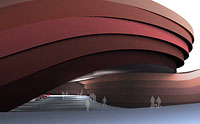 Design Museum, Holon, Israel, 2004, ongoing project
Design Museum, Holon, Israel, 2004, ongoing project
Museum with a 3100 m2 surface area with two large exhibition areas
that are flexible enough to be fitted out at will
© Ron Arad Associates
The Holon Design Museum, in the process of being completed, appears to be the work of an accomplished, recognised architect. Here curved lines are used in the form of five monumental ribbons that wrap around the building. Made of Corten steel, an alloy corroded at the surface often used for outdoor sculptures due to its resistance to climatic conditions, they take on shades of rust of varying intensity that change with the light creating an extraordinary beauty spot in the middle of the landscape. This building was presented in the exhibition thanks to a film projected onto the spiral walls of the Tel Aviv Opera house.
UNIQUE PIECES AND LIMITED EDITIONS![]()
As shown by the use of Corten steel for the design museum and the way it was cut into long wrap-around ribbons, the "physical" relationship with materials is essential in Ron Arad's work. This is the case with the unique pieces and limited editions displayed around the spiral of the opera house. Assembled, modelled, cut and moulded, the material is worked by the artist in a sort of hand to hand way. But while manual work is vital, Ron Arad combines the possibilities offered by new technologies while searching for experimentation and innovation.
Several mainlines – that obviously come together and interpenetrate – can allow you to decipher his work as it has developed over the years with each new discovery and encounter: borrowing, blurring borders between art and design, exploring form and experimenting with materials.
BORROWING
Borrowing was essentially used by Ron Arad at the start of his career. This design process is based on the use of pre-existing elements that are transformed when adapted by the artist. They thus give the work an identity while being turned aside from their initial meaning. Two symbolic designs from Ron Arad's beginnings reveal such an approach: the Rover Chair (1981) and the Concrete Stereo (1983).
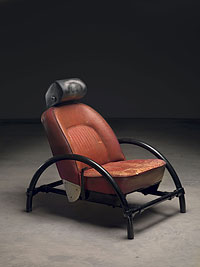 Rover Chair, 1981
Rover Chair, 1981
A salvaged leather-covered car seat,
fixed on a tubular epoxy lacquered steel structure ;
the tilting chair back leans on the circular arc structure
Height 78 x 69 x 92
cm
Produced by One Off, London
Private collection
© The Moumans Gallery (photo Eric and Petra Hesmerg)
Ron Arad's first foray into the world of design was done paradoxically at a time when the keynote was ready-made with the appearance of the Rover Chair in 1981. Once designed he decided to leave the architectural firm he was working for, this chair symbolising his desire to create his own works of art.
The Rover Chair is composed of a Land Rover seat salvaged by the artist from a scrap yard and two Kee-Klamp scaffolds to make it stable (for some time Ron Arad would take inspiration from the Kee-Klamp system to make tailor-made furniture components on request). Once transformed into an armchair and by using standardised components, the car seat adopts a whole new meaning while taking on a surrealistic appearance. After seducing fashion designer Jean-Paul Gaultier and grabbing Vitra's attention this was the object that really launched Ron Arad's career.
> See the presentation of the Kee Klamp system on the manufacture's website

> www.keeklamp.com
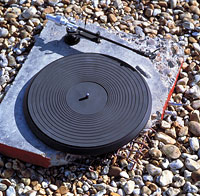 Concrete Stereo, 1983
Concrete Stereo, 1983
Record player, amplifier, 2 speakers,
electronic components incorporated into the concrete
Turntable 7,5 x 46 x 38 cm
Speaker 89 x 20 x 20 cm
Produced by One Off, London
Private collection
© The Gallery Moumans (photo Eric and Petra Hesmerg)
Ron Arad borrowed his material from construction to make Concrete Stereo : the hi-fi's different components (turntable, tuner, speakers) are in fact taken from reinforced concrete blocks. Instead of realising a perfect casing for this work Ron Arad poured the concrete roughly, leaving gaps to reveal the iron frames as if the concrete had been broken and damaged in places.
Playing around with destruction aesthetics this work also corresponds to an idea of producing several copies of objects that remain unique nonetheless. As Raymond Guidot points out: "Similar from one group to another, the objects, thanks to the subtle use of mastered defects, are nonetheless different. In fact, […] it's the material in the way it's implemented freely that calls the shots. It does so by refusing to fit the mould. Soon this will be in his skin spasms reacting to impacts and the action of fire." (In Raymond Guidot and Olivier Boissière, Ron Arad, Dis Voir publications, pp. 12-13.)
BETWEEN ART AND DESIGN
Turning to reflective materials, developing apparently unstable structures and erasing the object that became a support for the artistic design are just some of the many ways Ron Arad uses as a smoke screen. He thus offers the user a new design experience and an improved relationship with everyday objects. Without denying the comfort of a seat he insists on the need for "something else to happen" when you look at it then sit on it. Removing borders between art and design in some form or other is an attempt to disorient the user.
Reflections: D-Sofa (1994) and Chair by its cover (1989)
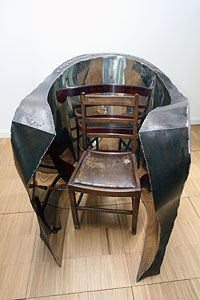 Chair by its cover, 1989
Chair by its cover, 1989
Polished stainless steel and wooden chair
20 copies produced
Produced by One Off, London
95 x 110 x 90 cm; 20 kg
Sergio Casoli Collection, Rome
The use of reflective materials notably polished stainless steel is one of the distinctive signs of Ron Arad's work. With their intermediate layers and use of reflections he gets the furniture to communicate with its environment and thus disrupts our points of reference both in how we construe the object as in our relationship with the space surrounding it. This is the case with D-Sofa, a distorted mirror deforming itself and the reality surrounding it. For Chair by its cover, Ron Arad created a concave mirror used as a setting for an ordinary wooden chair. Giving it armchair status he made it dissolve into its own reflections and thus acquire a new identity at the same time.
Instability: Beware of the Dog (1990) and At your own risk (1990)
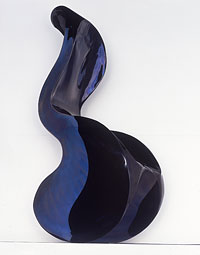 At Your Own Risk (A.Y.O.R), 1991
At Your Own Risk (A.Y.O.R), 1991
Polished steel with blue
98 x 50 x 48 cm
Produced by One Off, London from 1991 to 1999
Private collection
© Ron Arad Associates
Introducing uncertainty as far as the purpose of an object is concerned represents another way for Ron Arad to provide that "something extra" in design. He frequently adds the idea of an incurred risk to forms that lack clarity, notably through visible instability. The names he gives his creations like Beware of the Dog and more specifically At Your Own Risk are proof of this. The user must therefore "jump in", confront the object, overcome his or her parallels and give him or herself up to it to transform what at first sight resembles more of a sculpture than a piece of furniture.
Object erasing: Pic Chair (1997) and Lolita ceiling light (2004)

Lolita ceiling light, 2004
Ceiling light made of 21,000 crystals and
1,050 white LEDS capable of recording an SMS
and retranscribing it onto the crystals;
realised for the Milan trade show
25 copies issued
Produced by Swarovski, Wattens, Autriche
Swarovski Company, London
© Ron Arad Associates
You too can send an SMS to Lolita : 06.11.17.10.30
The public can be disoriented by transforming the design object into a support bearing an image. A symbolic work of art along these lines is Pic Chair. To make it, Ron Arad painted the inside of the mould with layers of pigmented polyester, fabrics and metal filings before injecting the polyester needed to make the chair. The layered polyester links the different elements together and represents the work's protective layer once removed from the mould. The painting is an integral part of the object that becomes a unique piece, hand-painted by the artist himself. This procedure was used again in 1999 for the New Orleans Chair with 18 copies produced by the Mourmans Gallery.
The Lolita ceiling light, a luminous spiral made of 21,000 crystals and created for Swarovski, can receive and retranscribe SMS messages sent by mobile phone thanks to the 1,050 inserted white LEDS. Ron Arad himself used this design as an example to illustrate the lack of relevance from the separation between art and design (cf. Judith Benhamou-Huet, "Ron Arad: Art, design, edition", in Marie-Laure Jousset (dir.), Ron Arad No Discipline, Paris, Pompidou Centre Publishing, 2008).
EXPLORING FORM
Coil: London Parpadelle (1992), This Mortal Coil (1993) and Ge-Off Sphere (2000)
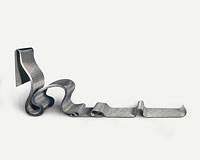 London Parpadelle Chair-rug, 1992
London Parpadelle Chair-rug, 1992
Stainless steel mesh welded onto a raw polished steel frame
Produced by One Off, Ron Arad Associates, London
102 cm x 206.5 cm x 60 cm
National contemporary art funds, ministry of art and communication, Paris
© FNAC (photo Bruno Scotti)
If there's a shape associated with Ron Arad it has to be the coil. In design as well as in architecture, the artist produces it in all materials, in different shapes with curved, winding lines, enriching his design with the freedom and the strength of calligraphy.
The London Parpadelle seat, like the long, flat pasta whose name it bears, thus follows a simple undulating uninterrupted line. The steel mesh layer it is made of is flexible and extends along the floor like a rug that can be rolled up to represent a footstool.
The solid, fixed coil used as a structure for the self-supporting bookcase This Mortal Coil echoes this undulating, supple coil. With this and by using a spiral divided up into pigeonholes, Ron Arad reinvents the bookcase and turns the whole concept of how we usually arrange books horizontally upside down.
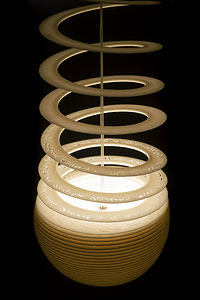 Ge-Off Sphere Ceiling light, 2000
Ge-Off Sphere Ceiling light, 2000
Not Made by Hand Not Made in China Collection
Polyamide, laser carbon dioxide powder sintering
Diameter: 50 cm
Produced by The Gallery Mourmans, Maastricht
Pompidou Centre, National museum of modern art – Centre of industrial design, Paris
AM 2003-1-19, donation from the Society of friends of the national modern art museum, 2003
© Ron Arad Associates
In 2000 the computer tool opened up new horizons to Ron Arad's formal inventiveness and allowed him to design the Ge-Off Sphere ceiling light in the Not Made by Hand Not Made in China series. He himself was surprised: "Who are these people who create software capable of satisfying our every whim? How were they able to predict from their valley that a designer from Chalk Farm (in London) would want to build, for example, a spiral ball with an ever-changing diameter, make it recoil, accurately record its distortions in a series of models then develop them into solid objects in a tank of epoxy resin?" (in Charlotte and Peter Fiell, Designing the 21st century, Taschen, 2002, p.41).
The reinterpreted archetype: Well Tempered Chair (1986) and Big E (2003)
 Big E Chair, 2003
Big E Chair, 2003
Recyclable rotomoulded polyethylene, cast in one piece
94 x 133 x 88 cm; 25 kg
Produced by Moroso, Cavalicco-Udine, Italy
© Ron Arad Associates
In 1986 Ron Arad took on a symbolic piece of furniture's history: the famous Club chair reinterpreted with the help of four sheets of stainless steel bent and fixed without welding, held only by screws. The Well Tempered Chair designed in this way is a paradoxical object that combines the comfortable and welcoming shapes of the traditional chair with the coldness of steel, with the additional instability that such a framework conjures up.
The Well Tempered Chair was the starting point of a series of variations on the theme of the club chair. In 1988 the Big Easy was designed which consequently reappeared under different guises. For the producer Moroso the Big Soft Easy cut in supple polyurethane, expanded and covered with textiles succeeded the patinated steel model or the one in carbon fibre. In 1999 the hand-painted New Orleans Chair that we talked about earlier was another variation. In 2003 the Big Easy returned under the name Big E in a recyclable rotomoulded polyethylene version. The model developed 20 years ago is still being researched by Ron Arad today.
In the meantime, he designed the Bad Tempered Chair for the manufacturer Vitra, made according to the principles of the original model but out of fibreglass and carbon fibre.
> See the presentation of the "Spring Collection" on Moroso's website
> See the Bad Tempered Chair on Vitra's website
EXPERIMENTING WITH MATERIALS
As the development of the Ge-Off Sphere or variants around the theme of the Club chair show, experimenting is essential in Ron Arad's work. Always attentive to the world of research and its innovations, Arad continuously explores new materials, the techniques that bring them into play and the production methods they generate. He has found in the manufacturer Ernest Mourmans an exceptional partner. In the latter's warehouse-gallery-workshop in Belgium, a lot of the designer's ideas and inventions take shape.
Blown aluminium: B.O.O.P. (1998)
In 1998 he used a machine – discovered by accident –, from the car and aeronautic industry, to develop the series of B.O.O.P. (Blown Out of Proportion). The technique developed with the help of this tool consists in blowing an alloy of superplastic aluminium heated in steel moulds to 500 degrees. The pieces obtained are then cut and polished to create unique objects-sculptures that seem to be "blown out of all proportion" and want to grow disproportionately.
Selective Laser Sintering (SLS): Movies Vases (1999)
The Movies vases are made by SLS: computer-assisted selective laser sintering. This quick prototyping technique allows the most complex shapes to be fashioned. In the case of the Movies vases, a 3D film showing a vase bouncing is paused several times. Each of the images thus obtained then go from the virtual to the real thanks to the polyamide powder sintered or fused by the laser's energy. (Cf. Ingeborg De Roode, "I want to make new things". The innovation in Ron Arad's work", in Marie-Laure Jousset (dir.), Ron Arad No Discipline, Paris, Pompidou Centre publications, 2008.) This technique is behind the Not Made by Hand, Not Made in China series offered by Ron Arad in 2000.
Paperwork Series (2002)
In 2002, the Paperwork series made use of a carbon fibre composite material and a honeycomb structure. Ron Arad thus continued his quest for new materials to develop new forms. Here delicacy combined with the resistance of the composite give scope to designing extremely lightweight furniture like the very elegant All Light Long table.
Corian® : Oh Void 2 (2004)
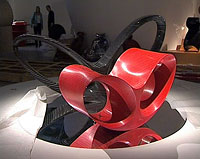 Oh Void 2 Chair, 2004
Oh Void 2 Chair, 2004
Corian ® red
116 x 197 x 46 cm
6 copies produced
Produced by The Gallery Mourmans, Maastricht
Stedelijk Museum, Amsterdam
© Ron Arad Associates (photo Tom Vack)
Then Corian® grabbed the designer's attention. Here in fact the initiative came from the manufacturer itself. The DuPont Company from Nemours, wanting to get recognition for this material, used very little despite being in existence for forty years asked Ron Arad to do an exhibition at the Furniture Trade Show in Milan in 2004. From there an installation, Lo-rez-dolores-tabula-rasa made by the designer was born in which Corian® surfaces let films and images show through. An acrylic resin-based plastic material, Corian® is in fact translucent. It can also be coloured, like the red Oh Void 2 seat. For the latter Ron Arad used the Corian® jointing technique that normally allows the seat to be put together without any visible joints. Here, thanks to this technique, he drew "thin stripes, like the topographical lines of a map" in the material.
While his collaboration with Ernest Mourmans is based on his desire to make limited editions only, another activity occupies the designer; that of adapting objects to industrial production for mass marketing. Several major pieces resulted from this research, including the best known Bookworm bookcase and the Tom Vac seat and the most recent PizzaKobra lamp.
 Bookworm, 1993
Bookworm, 1993
Adjustable Bookworm bookcase, 1993
Mass-coloured PVC, casting by injection
19 x 820 x 20 cm
Produced by Kartell, Italy
Pompidou Centre, National museum of modern art – centre of industrial design, Paris
Donation by Kartell 2000
AM 2000-1-63 © Ron Arad Associates
The Bookworm wall bookcase is undoubtedly the piece of Ron Arad's work that the general public know the most. Initially designed in steel and in a limited edition it then came in mass-coloured PVC, distributed on a large scale by Kartell. Made up of several sections of undulating shelves, it is undefined in length and is above all entirely adjustable depending on the way the different components are assembled. With this model Ron Arad offers a bookcase that meets the expectations of mass production and major outlets. It can indeed adapt to any room as well as to the needs and desires of each and everyone.
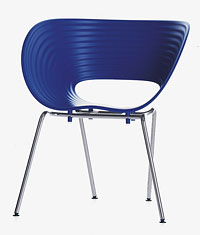 Tom Vac Chair, 1999
Tom Vac Chair, 1999
Moulded polypropylene shell; steel tube base
76 x 67 x 58 cm; 5 kg
Produced by Vitra, Weil am Rhein
Pompidou Centre, National museum of modern art – centre of industrial design, Paris
AM 2003-1-21, donation by Vitra International AG, 2003
© Ron Arad Associates
Like the Bookworm bookcase the Tom Vac chair wasn't designed for mass marketing to begin with. In fact it was primarily designed as an experiment with aluminium; it was only afterwards that it was mass produced by Vitra, becoming one of Ron Arad's biggest commercial successes. Designed to be stacked easily, it is made up of a steel tube base on which a simple lightweight, resistant and enveloping moulded polypropylene shell is fixed.
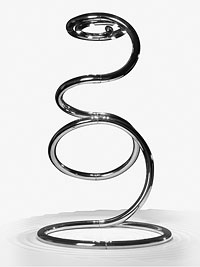 Pizzakobra Lamp, 2007
Pizzakobra Lamp, 2007
Chromed aluminium, LED light bulb 6 x 1 w
Diameter 26 cm; Height closed 1.85 cm, deployed 73.5 cm; 2.5 kg
Produced by IGuzzini, Recanati, Italy
© Ron Arad Associates
One of Ron Arad's most recent designs intended for mass marketing is the PizzaKobra lamp produced by iGuzzini in 2007. Following the designer's search for flexibility and thanks to its articulated metallic structure, when folded up it adopts a flat, circular shape that can stand up when you want like a snake in various poses.
CONCLUSION: FROM ROVER TO MOREOVER![]()
The world of design recently witnessed the return of the Rover Chair with Moreover by Vitra. This sophisticated version of the original work of art comes in two models in a limited edition: one in stainless "chromed" steel, the other in "rust" patinated steel. The old kee-klamp base-arm is replaced by moulded steel pieces fixed to the chair. Reinterpreting the symbolic work of his beginnings Moreover is a reference to the evolution that the designer's work has experienced in the past twenty six years.
Besides his interest for collectors, this project finally shows what's so special about Ron Arad, in other words his tendency to constantly reinterpret his work to design new works of art, whether unique or intended for mass production. As Judith Benhamou-Huet points out: "we can see there a desire to profit from ideas to a maximum, or on the contrary, interpret this practice as a purely conceptual approach, and by doing so obey an artistic belief" (Judith Benhamou-Huet, "Ron Arad: Art, design, edition", in Marie-Laure Jousset (dir.), Ron Arad No Discipline, Paris, Pompidou Centre publications, 2008) Without a doubt all this occurs in the designer's work simultaneously with other parameters. In any case this ability to constantly create another version of his language and his way of thinking is what makes the Ron Arad brand and the wealth of all his works of art.
Works
- Marie-Laure Jousset (dir.), Ron Arad No Discipline,
Paris, Pompidou Centre Publications, 2008 ![]()
- Matthew Collings, Ron
Arad Talks to Matthew Collings, New York, Phaidon, 2004
- Raymond Guidot and Olivier Boissiere, Ron Arad,
Paris, Dis Voir, 1998
Film
- Judith Du Pasquier, L'art et la manière :
Ron Arad, Arte et Image & Compagnie, 2005, 25'. See a few images of the film on Arte Vod's web site ![]()
- Danielle Schirmann, The Bookworm, Arte, Pompidou Centre,
Steamboat Films, Lobster Films, 2007,
Websites
- Ron Arad's website www.ronarad.com ![]()
- Mourman Gallery's website www.thegallerymourmans.com ![]()
- The producer's Vitra's website www.vitra.com ![]()
- The producer's Moros's website www.moroso.it ![]()
- The producer's Kartell's website www.kartell.it ![]()
- The iGuzzini company's website www.iguzzini.fr ![]()
© Pompidou Centre, Department of educational action and publics, December 2008
Text: Noémie Giard
Translated by Vice versa
Model: Michel Fernandez, Maud Thiria-Pompidou
On-line file at www.centrepompidou.fr/education/ subsite 'Educational files' ![]()
Coordination : Marie-José Rodriguez
To refer to other files
In French ![]()
In English ![]()
Contacts
To meet your expectations to the best of our ability, we would like to know your reactions and suggestions concerning this document. You can contact us via our website, subsite Contact,
thème éducation ![]()